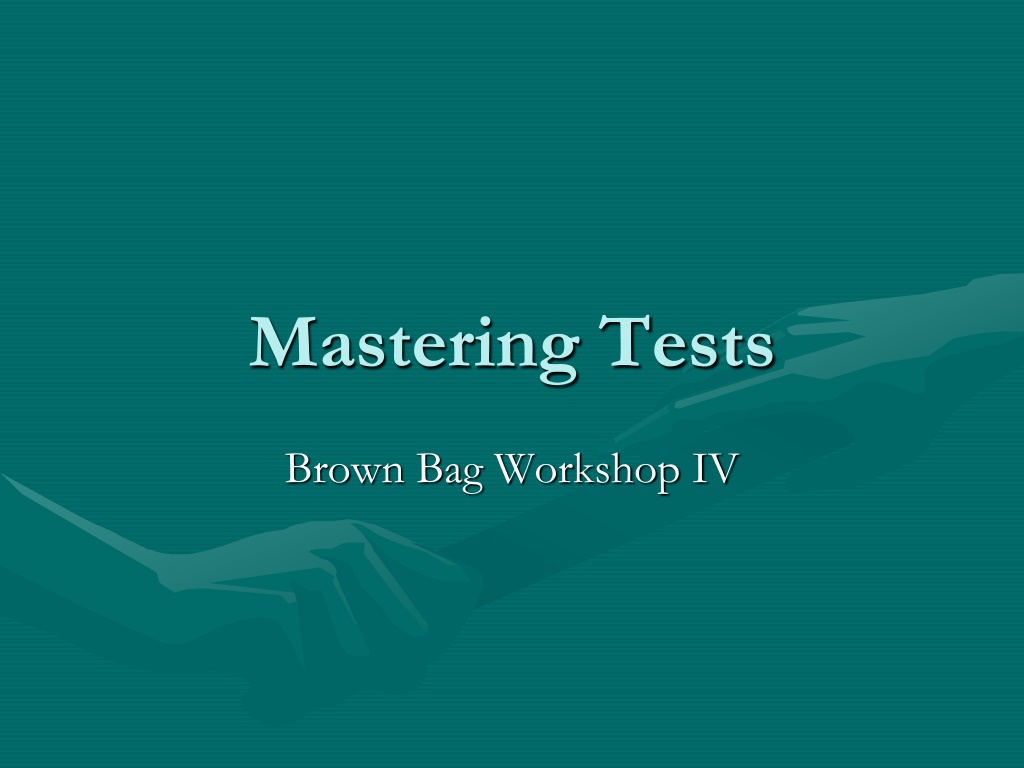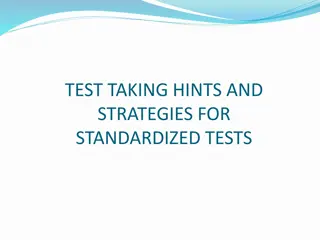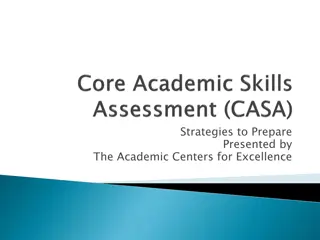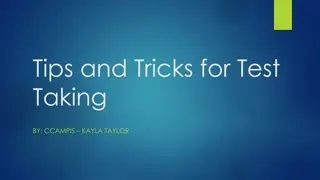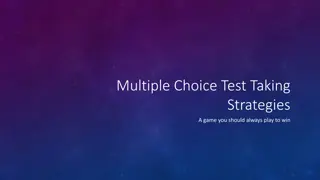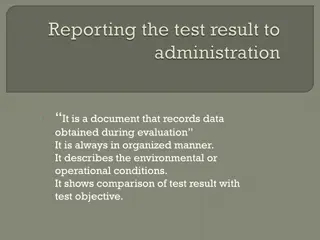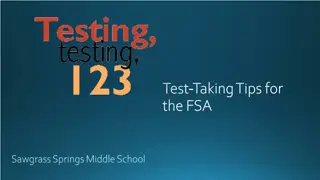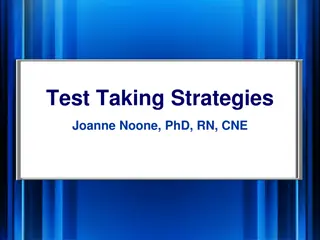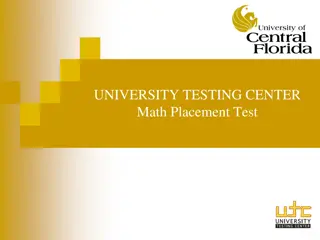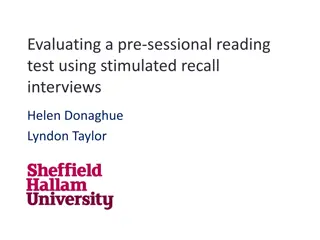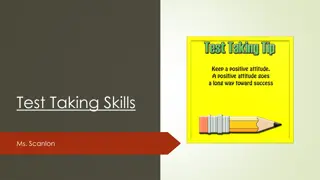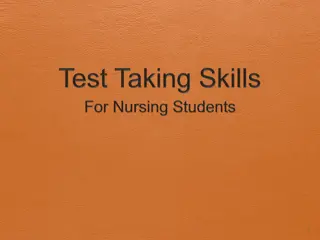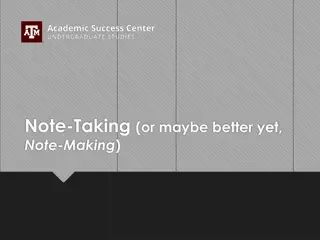Effective Test-Taking Strategies for Success
Enhance your test-taking skills with these powerful strategies: believe in yourself, arrive early, organize tools, ignore distractions, preview questions, budget time, write in margins, tackle easy questions first, navigate multiple-choice questions smartly. These tips will boost your confidence and optimize your performance during examinations.
Download Presentation

Please find below an Image/Link to download the presentation.
The content on the website is provided AS IS for your information and personal use only. It may not be sold, licensed, or shared on other websites without obtaining consent from the author. Download presentation by click this link. If you encounter any issues during the download, it is possible that the publisher has removed the file from their server.
E N D
Presentation Transcript
Mastering Tests Brown Bag Workshop IV
Ten Rules To Taking Tests 1. Know you can succeed ~ Your thoughts are powerful! Negative thoughts can increase stress levels and lower your confidence which can lead to feelings of failure Arrive early ~ It will set your mind at ease, you can get your favorite seat and can take time to mentally and physically relax before the test. Bring tools ~ extra pens, pencils, erasers, a calculator, a watch , a dictionary or other items you may need. Ignore panic pushers ~ Don t take time to cram just because you have arrived early. Instead, review what you do know. Panic pushers cause students to become more nervous before a test and they frantically ask questions about the material they studied in fear they don t know the answers. 2. 3. 4.
5. Pre-view the playing field write your name on your paper this may seem obvious, but often students are so anxious to start the test that they forget their name listen to instructions and read directions carefully ~ Avoid careless errors by reading the instructions carefully and asking questions of your instructor to explain any directions that are unclear. determine the amount of time you have budget your time Budget your time and stick to your limits so that you can be sure to always complete the test in the amount of time given look for answers within the test ~ look for questions that answer other questions. Instructors often test you on concepts in more than one way. You may see a concept or word in a multiple choice question and you can use it in a short answer or fill-in-the-blank Write in the margins ~ Write key terms, formulas, dates, names and other information in the margins so you won t forget them. 6.
7. Complete easy questions first ~ This helps to build your confidence. Flag tough questions and come back to them later. Don t spend too much time on difficult questions. Know if there is a penalty for guessing ~ If you are running out of time and there is no penalty for guessing, do so. On the other hand, if your test has a penalty for guessing, choose your answer wisely and leave blank answers you do not know. Avoid changing your answers ~ Research indicates that three out of four times your first choice is correct. Avoid changing answers unless you are absolutely sure it is wrong. Write clearly and neatly ~ Is your test easy to read or does it look messy? The easier your test is to read the better your chance of getting a higher grade. 8. 9. 10.
Test Taking Strategies Multiple Choice Questions Study the question Circle qualifiers or key words Guess the answer before reading choices ~see if you know the answer first Break question down into parts Read all of the choices before making a decision Eliminate obviously wrong answers ~ the fewer choices you have to choose from, the your odds of getting the right answer Flag questions you re not sure about (and come back to them later) If time permits, recheck your answers Look for flagged questions first ~ those you didn t answer Before changing any answers, be sure you have a very good reason to do so ~your first response is usually correct
Activity One Sample Multiple Choice Questions 1. Bears are commonly found wandering A. in the woods B. in parks C. in fields D. in the mountains E. all of the above The answer is e . Bears can be found in woods, parks, fields, and mountains. If you did answered the question without looking at all the choices you might have chosen incorrectly. 2. Students frequently succeed in test taking because A. all tests are easy B. they are usually prepared C. they always do their assignments on time D. they always try hard Frequently is also a key word. Which answer best reflects the same key word. Answers b,c, and d all contain qualifiers (all and always) they are different than are most closely reflects that question.
Activity One Cont 3. The reason most students give for failing tests include: A. studying the wrong information B. cramming and being unprepared C. not having enough time to study D. being given unfair tests Here the correct answer is b the question asks for reasons (plural) and b is the only one that gives you two reasons, therefore it must be the correct answer. 4. All of the following are ingredients of student success except: A. taking good notes B. studying ahead of time C. learning from mistakes D. cramming for exams Here the correct answer is d If you look at each statement as true or false, you will notice that a,b, and c are all true. d is false. Since it the only false statement, or different statement it must be the correct answer.
Test Taking Strategies True/False Questions Read each question carefully ~ do not analyze questions for deeper meaning look for key words Look for definites and absolutes ~most but not all statements with definites and absolutes are false. Definite/Absolute Terms All Always Never Everyone Nobody Is/are Must None Absolutely Some Exception Terms Sometimes Someone Could/might Possibly
True False Questions true/false statement is, the more likely it is to be true Look to see if there is a given number of true and false statements (4 true ~ 6 false) there tend to be more true answers than false because false questions are more difficult to write, if you MUST guess, guess TRUE! Statements with reasons tend to be false because they are often incorrect or incomplete reasons. Don t change your answers Look for double negatives Look for the length of the statement ~ the longer a
Activity Two Sample True/False Questions 1. All people have similar ways of learning - False The word all is too absolute 2. The best time to begin reviewing for a test is within 24 hours of the test False The word best is too definite 3. Men are usually physically stronger than women. - True Usually leaves room for exception 4. Some birds do not fly - True some leaves room for exception 5. Milk is not a nonalcoholic beverage. This question contains a double negative. The words not and the prefix non both imply negativism. Cross off one or the other and reread the question. For example Milk is a nonalcoholic beverage. The statement is true If a statement has 3 negatives, cross two of them and answer the question
Test Taking Strategies Matching Tests Count the possible answers ~are there more answers than questions, can answers be used more than once If you are not sure ask Review all possible choices before answering ~the better answer may be at the end of the list. Read all the answers first before making a decision Use the process of elimination Answer easy questions first and then answer the more difficult ones through the process of elimination. Mentally repeat the choices say the terms and then go down each possible answer and fill in the best answer. Cross off answers as you go
Test Taking Strategies Fill-in-the-Blank Tests Complete fill-in-the-blank questions last ~You may find an answer somewhere else in the test Be sure your answer makes sense ~once you ve filled in the blank read the statement to be sure it seems correct Questions with plural verbs are asking for more than one answer. Questions with a singular verb are looking for one answer. If the word an appears before the blank, the answer must start with a vowel. Consider the length of the blank ~A short blank means a short answer/word. A long blank means a long answer or word. Two blanks means two words etc Write legibly
Test Taking Strategies Essay Tests a. Read the directions carefully how many essay questions do you need to answer ~sometimes you only need to answer for example 3 out of 5 questions how long should the essay be ~ often the instructor will tell you how long each answer should be how should you budget your time ~ the amount of time you spend on each answer depends on how many points it is worth how many components do you need to discuss ~Some essay questions are two or more parts or require you to answer more than one question. Be sure to answer all parts of a question what type of answer should you give ~make sure you understand what the question is asking. Avoid giving your opinion unless you are asked to b. c. d. e.
Test Taking Strategies Overcoming Test Anxiety Before the Test a. Discuss the test with the instructor or other classmates ~ will the exam be from the text or lecture, what type of test will it be, how many points, may I have extra time to finish etc . b. Prepare ~the main reason most students fail is due to poor preparation; not reading the text, poor notes, not keeping up on or doing assignments c. Don t cram ~ review over several days d. Have a positive attitude ~ positive attitudes often yield positive results
